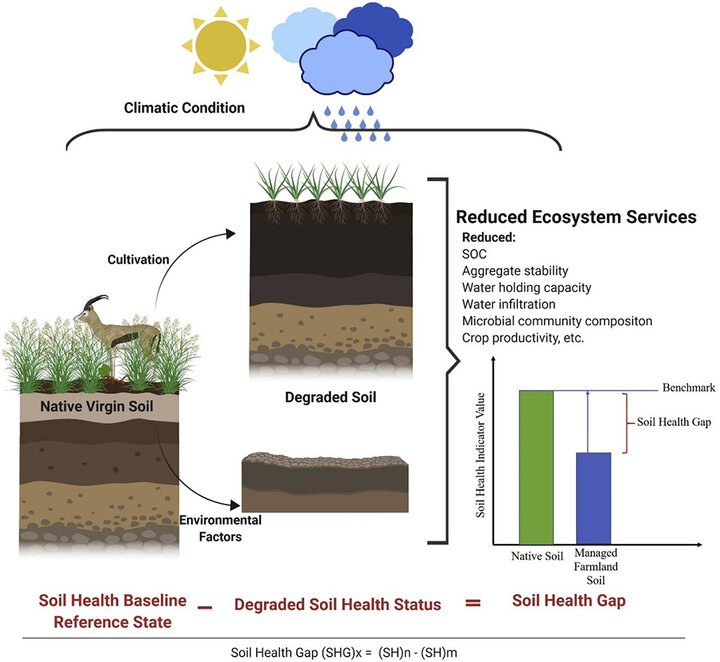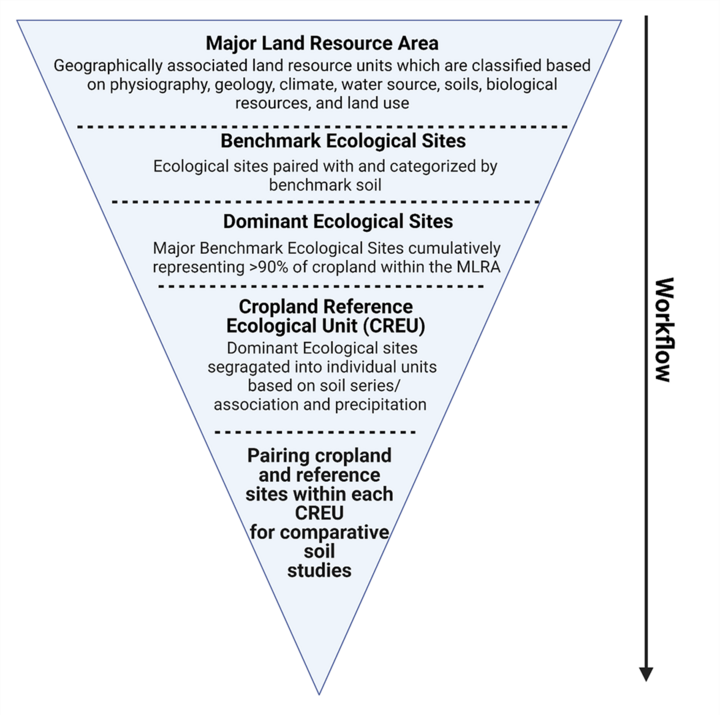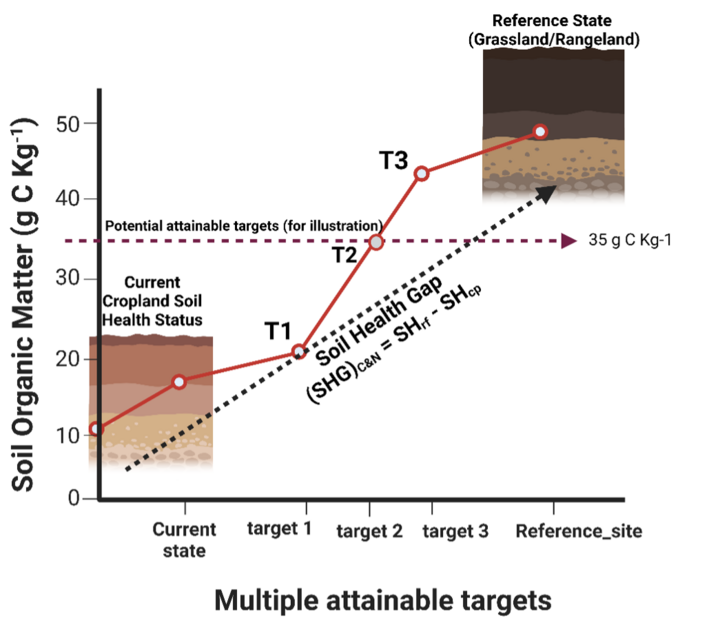Concerns over the sustainability of the soil ecosystem being impeded in its ability to produce food, fiber and fuel for the growing world population have helped coalesce efforts around soil health management and research. Currently, soil bio-physicochemical properties are measured as indicators of soil health in croplands to identify management practices that can maintain or improve those properties relative to their roles as ecosystem services. As one manages cropland following soil health principles to improve soil health, it will be helpful to know:
Question 1. How do you benchmark soil health in croplands?
In that regard, Maharjan and Das (2020) proposed the "Soil Health Gap" concept that compares soil health in cropland and native undisturbed land, providing a measure of soil health change in croplands since cultivation began and simultaneously setting potential soil health targets (Figure 1). However, comparing croplands with reference native sites or croplands or among cropland and native lands can be confounded with agroecological variations, including the vast heterogeneity in soil and climate. The precipitation gradient and soil variation based on pedogenetic differences or soil genoform can create differences in the soil health potential. For that reason, the response experience to different soil health management practices could mostly be site-specific.

Question 2. How far apart can sites be when you compare soils under different land use or management practices? Can we compare sites from Lancaster with Scotts Bluff?
Any comparative soil (health) studies should consider the soil and climatic variability and group the soils based on their native soil health potential. Das and Maharjan (2022), in their recent effort and as a part of UNL–NRCS collaborative conservation project “Interactive Soil Health Reference Mapping for the State of Nebraska,” developed a novel landmass classification unit, Cropland Reference Ecological Unit (CREU), using and prioritizing factors within the existing NRCS land resource classification.
A Cropland Reference Ecological Unit (CREU) is a land area with presumably uniform pedogenetic and climatic properties and where sites can be compared with less confounding factors by extenuating agroecological variation. For CREU development, in each MLRA, only the top-ranked benchmark ecological sites (ecological sites categorized based on benchmark soils) cumulatively relevant to >90% of croplands are selected and are referred to as Dominant Ecological Sites for crop production (Figure 2). Individual dominant ecological sites are then divided into discrete landmass units as a function of the dominant and agronomically critical soil association(s) and a local precipitation range to determine the CREU (Figure 2). Depending on the application and purpose, a generalized CREU can be created from ecological sites. Since our effort here was to benchmark soil health potential for croplands, we categorized ecological sites into dominant ecological sites, accounting for >90% of crop cover, thus, prioritizing sites of greater relevance within the region of interest and serving the objective. Detailed methodology and delineation criteria for CREU can be found at https://doi.org/10.1016/j.ecolind.2022.109468.
The concept of a CREU will provide a level platform for comparative studies where soil health can be assessed and compared for a group of sites with presumably similar soil health potential. If measured in the same CREU, soil health at different sites will provide actual differences due to land use or management practices. Further, the concept of a CREU can provide a geographically universal framework for comparative studies between parcels of land by accounting for the different native potentials based on the soil and climate and be reported simply as the Soil Health Gap.

Q3. Once the Soil Health Gap is properly estimated under the CREU framework, what is my soil health target?
While the soil health gap sets the ceiling, the actual gain in soil health using available soil health management will be in between the current cropland and reference state, the potential attainable targets (Figure 3). The greater the gap to close, multiple and enduring soil health practices would be required. It may take several years and a suite of conservation practices to improve soil health and close the Soil Health Gap. By knowing the soil health gap, you can set your soil health targets or multiple attainable targets to reach the reference status or potential attainable targets.

Q4. How can I locate reference site for comparative studies?
Reference site should be a native land or grassland for comparative studies. However, a reference site can be sometimes hard to locate. In such cases, a site of interest can be compared to sites from higher categories in land suitability groups to estimate soil health gap and potential soil health targets. A list of land suitability groups is provided in Table 1, where the likelihood of soil damage or loss of soil quality becomes progressively greater from class A to D. Thus, a producer running business-as-usual management can compare his cropland with one that is using conservation practices in his Cropland Reference Ecological Unit to determine the gap and potentially set the target for soil health improvement.
| Group — A Unmanaged Land | Group — B Minimally or optimally managed land | Group — C Moderately managed land | Group — D Intensively managed land |
|---|---|---|---|
| Native forest Native prairie Natural grassland |
Cropland retired for >50 years Rangeland |
Croplands with conservation practices Rangeland with prescribed burning |
Croplands with conventional practices Grazing lands with heavy grazing |
§Groupings are based on land management ranging from unmanaged land to intensively managed croplands. The concept of land suitability classification for comparative soil health studies shares the idea of the land capability assumption of USDA NRCS.
Acknowledgement
The authors thank Natural Resources Conservation Service (USDA NRCS) for their support and fundings to carry out this project.
